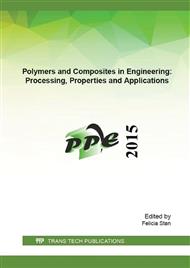[1]
N.T. Dintcheva, R. Arrigo, M. Morreale, F.P. La Mantia, R. Matassa, E. Caponetti, Effect of elongational flow on morphology and properties of polymer/CNTs nanocomposite fibers, Polym. Adv. Technol. 22 (2011) 1612-1619.
DOI: 10.1002/pat.1648
Google Scholar
[2]
J.Z. Liang, C.Y. Chen, S.Y. Zou, C.P. Tsui, C.Y. Tang, S.D. Zhang, Melt flow behavior of polypropylene composites filled with multi-walled carbon nanotubes during extrusion, Polym. Test. 45 (2015) 41-46.
DOI: 10.1016/j.polymertesting.2015.05.002
Google Scholar
[3]
L. Santo, G.M. Tedde, F. Quadrini, I. Mutlay, CNT and graphene filled shape memory foams by solid state foaming, Key Eng. Mater. 651-653 (2015) 719-725.
DOI: 10.4028/www.scientific.net/kem.651-653.719
Google Scholar
[4]
S. Iijima, Helical microtubules of graphitic carbon, Nature 354 (1991) 56-58.
DOI: 10.1038/354056a0
Google Scholar
[5]
Z. Spitalskya, D. Tasisb, K. Papagelisb, C. Galiotis, Carbon nanotube–polymer composites: Chemistry, processing, mechanical and electrical properties, Prog. Polym. Sci. 35 (2010) 357-401.
DOI: 10.1016/j.progpolymsci.2009.09.003
Google Scholar
[6]
H. Jin-Hua, Z. Hui, C. Ming-Ji, W. Guo-Rui, Z. Zhong, CNT buckypaper/thermoplastic polyurethane composites with enhanced stiffness, strength and toughness, Compos. Sci. Technol. 103 (2014) 63-71.
DOI: 10.1016/j.compscitech.2014.08.015
Google Scholar
[7]
J.N. Coleman, U. Khan, W.J. Blau, Y.K. Gunko, Small but strong: a review of the mechanical properties of carbon nanotube–polymer composites, Carbon 44 (2006) 1624-1652.
DOI: 10.1016/j.carbon.2006.02.038
Google Scholar
[8]
D.J. Martin, A.F. Osman, Y. Andriani, G.A. Edwards, Thermoplastic polyurethane (TPU)-based polymer nanocomposites, in: Composites Science and Engineering, 2012, pp.321-350.
DOI: 10.1533/9780857096241.2.321
Google Scholar
[9]
A. Martinez, J. Castany, D. Mercado, Characterization of viscous response of a polymer during fabric IMD injection process by means a spiral mold, Measurement 44 (2011) 1806-1818.
DOI: 10.1016/j.measurement.2011.09.011
Google Scholar
[10]
V. Speranza, U. Vietri, R. Pantani, Monitoring of Injection Molding of Thermoplastics: Average Solidification Pressure as a Key Parameter for Quality Control, Macromol. Res. 19 (2011) 542-554.
DOI: 10.1007/s13233-011-0610-9
Google Scholar
[11]
S. Gunasekaran, M. Mehmet Ak, Cheese Rheology and Texture, CRC Press, (2003).
Google Scholar
[12]
Information on www. nanocyl. com – Nanocyl, Technical Data Sheet.
Google Scholar
[13]
C. Schilde, M. Schlomann, A. Overbeck, S. Linke, A. Kwade, Thermal, mechanical and electrical properties of highly loaded CNT-epoxy composites – A model for the electric conductivity, Compos. Sci. Technol. 117 (2015) 183-190.
DOI: 10.1016/j.compscitech.2015.06.013
Google Scholar
[14]
P. Theilmann, D.J. Yun, P. Asbeck, S.H. Park, Superior electromagnetic interference shielding and dielectric properties of carbon nanotube composites through the use of high aspect ratio CNTs and three-roll milling, Org. Electron. 14 (2013).
DOI: 10.1016/j.orgel.2013.02.029
Google Scholar
[15]
E. Mitsoulis, S.G. Hatzikiriakos, Bagley correction: the effect of contraction angle and its prediction, Rheol. Acta 42 (2003) 309-320.
DOI: 10.1007/s00397-003-0294-y
Google Scholar
[16]
G. Schramm, A practical approach to rheology and rheometry, Gebrueder HAAKE GmbH, Karlsruhe, Germany, (1998).
Google Scholar
[17]
F.A. Morrison, Understaning rheology, Oxford University Press Inc., (2001).
Google Scholar
[18]
WinRHEO II – Program Documentation of GOTTFERT.
Google Scholar


